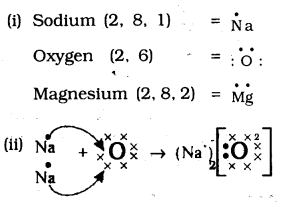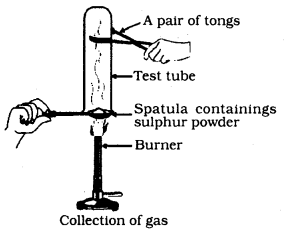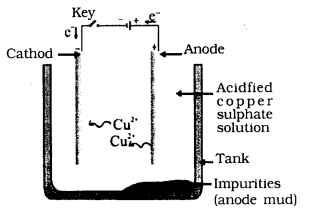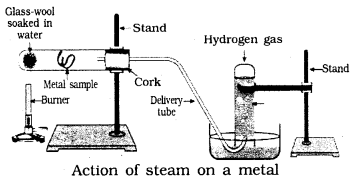KSEEB SSLC Class 10 Science Solutions Chapter 3 Metals and Non-metals are part of KSEEB SSLC Class 10 Science Solutions. Here we have given Karnataka SSLC Class 10 Science Solutions Chapter 3 Metals and Non-metals.
Karnataka SSLC Class 10 Science Solutions Chapter 3 Metals and Non-metals
KSEEB SSLC Class 10 Science Chapter 3 Intext Questions
Text Book Part I Page No. 40
Question 1.
Give an example of a metal which
- is a liquid at room temperature
- can be easily cut with a knife.
- is the best conductors of heat.
- is a poor conductor of heat.
Answer:
- Metal that exists in a liquid state at room temperature → Mercury.
- Metal that can be easily cut with a knife → Sodium.
- Metal that is the best conductor of heat → Silver.
- Metals that are poor conductors of heat → Lead.
Question 2.
Explain the meanings of malleable and ductile.
Answer:
- Malleable: Materials that can be beaten into thin sheets are called malleable.
- Ductile: Materials that can be drawn into thin wires are called ductile.
Metals can be hammered into thin sheets. This property of a metal is called malleability and the metals showing this property are called malleable. Gold, Silver, Copper, aluminium etc are malleable metals. Metals can be drawn into wires. The ability of metals to be drawn into thin wires is called ductility. Gold is the most ductile metal. It is interesting to know that a wire of about 2 km length can be drawn from one gram of gold.
Text Book Part I Page No. 46
Question 1.
Why is sodium kept immersed in kerosene oil?
Answer:
Sodium is a highly reactive element. If kept in open, it can react with oxygen and cause an explosion which results in a fire. Hence, to prevent accidental damage sodium is immersed in kerosene oil.
Question 2.
Write equations for the reactions of
- iron with steam
- calcium and potassium with water
Answer:
3Fe(s) + 4H2O(g) → Fe3O4(aq) + 4H2(g)
Ca(s) + 2H2O(l) → Ca(OH)2(aq) + H2(g) + Heat
2K(s) + 2H2O(l) → 2KOH(aq) + H2(g) + Heat
Question 3.
Samples of four metals A, B, C and D were taken and added to the following solution one by one. The results obtained have been tabulated as follows.
| Metal | Iron(II) Sulphate | Copper(II) sulphate | Zinc sulphate |
Silver nitrate |
| A | No reaction | Displacement | ||
| B | Displacement | No reaction | ||
| C | No reaction | No reaction | No reaction | Displacement |
| D | No reaction | No reaction | No reaction | No reaction |
Use the Table above to answer the following questions about metals A, B, C and D.
- Which is the most reactive metal?
- What would you observe if B is added to a solution of Copper(II) sulphate?
- Arrange the metals A, B, C and D in the order of decreasing reactivity.
Answer:
- Most reactive metal is B.
- B will displace copper from copper sulphate.
- Order of decreasing reactivity – B > A > C > D.
Question 4.
Which gas is produced when dilute hydrochloric acid is added to a reactive metal? Write the chemical reaction when iron reacts with dilute H2SO4.
Answer:
When dilute hydrochloric acid is added to a reactive metal, Hydrogen gas is liberated.
Fe(s) + H2SO4(aq) ➝ FeSO4(aq)+H2(g)
Iron reacts with dilute hydrochloric acid and forms Iron sulphate and Hydrogen gas.
Question 5.
What would you observe when zinc is added to a solution of iron(II) sulphate? Write the chemical reaction that takes place.
Answer:
When Zinc is added to a solution of iron (II) sulphate, Iron is displaced by FeSO4.
Zn(s) + FeSO4(aq) ➝ ZnSO4(aq) + Fe(S)
Text Book Part I Page No. 49
Question 1.
(i) Write the electron-dot structures for sodium, oxygen and magnesium.
(ii) Show the formation of Na2O and MgO by the transfer of electrons.
(iii) What are the ions present in these compounds?
Answer:

(iii) Ions in Na2O are Na+ and O2- Ions in MgO are Mg2+ and O2-
Ions in MgO are Mg2+ and O2-
Question 2.
Why do ionic compounds have high melting points?
Answer:
Ionic compounds have strong electrostatic forces of attraction between the ions. Therefore, it requires a lot of energy to overcome these forces. That is why ionic compounds have high melting points.
Text Book Part I Page No. 53
Question 1.
Define the following terms.
- Mineral
- Ore
- Gangue
Answer:
- Mineral: The naturally occurring compounds and elements are known as a mineral.
- Ore: Minerals from which metals can be extracted profitably are known as ores.
- Gangue: The impurities present in the ore such as sand, rocks etc. are known as gangue.
Question 2.
Name two metals which are found in nature in the free state.
Answer:
Gold and Platinum.
Question 3.
What chemical process is used for obtaining a metal from its oxide?
Answer:
Reduction process is the chemical process used for obtaining a metal from its oxide.
![]()
Text Book Part I Page No. 55
Question 1.
Metallic oxides of zinc, magnesium and copper were heated with the following metals.
| Metal | Zinc | Magnesium | Copper |
|
Zinc oxide Magnesium oxide Copper oxide |
In which cases will you find displacement reactions taking place?
Answer:
|
Metal |
Zinc | Magnesium |
Copper |
|
Zinc oxide |
No displacement reaction | Displaces | No displacement reaction |
|
Magnesium oxide |
– | Displaces |
– |
| Copper oxide | Displaces |
Displaces |
– |
Question 2.
Which metals do not corrode easily?
Answer:
Metals which have low reactivity such as silver and gold does not corrode easily.
Question 3.
What are alloys?
Answer:
An alloy is a homogenous mixture of two or a metal and non-metal.
KSEEB SSLC Class 10 Science Chapter 3 Textbook Exercises
Question 1.
Which of the following pairs will give displacement reactions?
(a) NaCl solution and copper metal
(b) MgCl2 solution and aluminium metal
(c) FeSO4 solution and silver metal
(d) AgNO3 solution and copper metal.
Answer:
(d) AgNO3 solution and copper metal.
Question 2.
Which of the following methods is suitable for preventing an iron frying pan from rusting?
(a) Applying grease
(b) Applying paint
(c) Applying a coating of zinc
(d) All of the above.
Answer:
(c) Applying a coating of zinc.
Question 3.
An element reacts with oxygen to give a compound with a high melting point. This compound is also soluble in water. The element is likely to be
(a) calcium
(b) carbon
(c) silicon
(d) iron
Answer:
(a) calcium.
Question 4.
Food cans are coated with tin and not with zinc because
(a) zinc is costlier than tin.
(b) zinc has a higher melting point than tin.
(c) zinc is more reactive than tin.
(d) zinc is less reactive than tin.
Answer:
(c) zinc is more reactive than tin.
Question 5.
You are given a hammer, a battery, a bulb, wires and a switch.
(a) How could you use them to distinguish between samples of metals and non-metals?
(b) Assess the usefulness of these tests in distinguishing between metals and non-metals.
Answer:
- With the hammer, on beating the sample if it changes into thin sheets (that is, it is malleable), then it is a metal otherwise a non-metal. Similarly, we can use the battery, bulb, wires, and a switch to set up a circuit with the sample. If the sample conducts electricity, then it is a metal otherwise a non-metal.
- The above tests are useful in distinguishing between metals and non-metals as these are based on the physical properties. No chemical reactions are involved in these tests.
Question 6.
What are amphoteric oxides? Give two examples of amphoteric oxides.
Answer:
The oxides which behave as both acidic and basic oxides are called amphoteric oxides. Examples: Aluminium oxide (A2O3), zinc oxide (ZnO).
Question 7.
Name two metals which will displace hydrogen from dilute acids, and two metals which will not.
Answer:
- Iron and aluminium will displace hydrogen from dilute acids because of being more reactive than
- hydrogen. Mercury and copper cannot displace hydrogen from dilute acids because of being less reactive than hydrogen.
Question 8.
In the electrolytic refining of a metal M, what would you take as the anode, the cathode and the electrolyte?
Answer:
In the electrolytic refining of a metal M, impure metal is connected to Anode and pure metal thin sheet is connected to cathode. Electrolyte is Acidified Copper sulphate.
- Iron and aluminium will displace hydrogen from dilute acids because of being more reactive than
- hydrogen. Mercury and copper cannot displace hydrogen from dilute acids because of being less reactive than hydrogen.
In the electrolytic refining of a metal M, impure metal is connected to Anode and pure metal thin sheet is connected to cathode. Electrolyte is Acidified Copper sulphate.
- Anode → Impure metal, M.
- Cathode → Thin strip of pure metal, M.
- Electrolyte → Aqueous solution of a salt of the metal, M.
Question 9.
Pratyush took sulphur powder on a spatula and heated it. He collected the gas evolved by inverting a test tube over it, as shown in figure below.

(a) What will be the action of gas on
(i) dry litmus paper?
(ii) moist litmus paper?
(b) Write a balanced chemical equation for the reaction taking place.
Answer:
a) (i) No action of gas on diy litmus paper.
(ii) In case of moist litmus paper, it turns red. Because sulphur is a non metal. Oxides of Non metal are acidic.
b) S(s) + O2(g) ➝ SO2(g)
Question 10.
State two ways to prevent the rusting of iron.
Answer:
Two ways to prevent the rusting of iron are:
- Oiling, greasing, or painting:
By applying oil, grease, or paint, the surface becomes waterproof. The moisture and oxygen present in the air cannot come into direct contact with iron. Hence, rusting is prevented - Galvanization:
An iron article is coated with a layer of zinc metal, which prevents the iron to come in contact with oxygen and moisture. Hence, rusting is prevented.
Question 11.
What type of oxides are formed when non-metals combine with oxygen?
Answer:
When non metals combine with oxygen, neutral oxides or Acidic oxides are formed.
Eg: NO2, SO4 are acidic oxides NO, CO are neutral oxides.
Question 12.
Give reasons:
(a) Platinum, gold and silver are used to make jewellery.
(b) Sodium, potassium and lithium are stored under oil.
(c) Aluminium is a highly reactive metal, yet it is used to make utensils for cooking.
(d) Carbonate and sulphide ores are usually converted into oxides during the process of extraction.
Answer:
a) Platinum, gold and silver are used to make jewellery because they are shining metals and ress reactive and they do not corrode easily.
b) Sodium, Potassium and Lithium are highly reactive metals. These metals react so vigorously that they catch fire if kept in the open.
Hence to protect them and to prevent accidental fire, they are kept immersed in kerosene oil.
c) Aluminium is highly reactive metal. It does not rust. Because it combines with oxygen and forms Aluminium oxide. The protective oxide layer prevents the metal from further oxidation and Aluminium is light, good conductor of heat. Hence this is used to make utensils for cooking.
d) The metals in the middle of the activity series such as iron, zinc, lead, copper are moderately reactive. These are usually present as sulphides or carbonates in nature. It is easier to obtain a metal from its oxide, as compared to its sulphides and carbonates. Therefore prior to reduction, the Metal sulphides and carbonates must be converted into metal oxides.
Question 13.
You must have seen tarnished copper vessels being cleaned with lemon or tamarind juice. Explain why these sour substances are effective in cleaning the vessels.
Answer:
Copper-reacts with moist carbon dioxide in the air to form copper carbonate and as a result, copper vessel loses its shiny brown surface forming a green layer of copper carbonate. The citric acid present in the lemon or tamarind neutralises the basic copper carbonate and dissolves the layer. That is why tarnished copper vessels are cleaned with lemon or tamarind juice to give the surface of the copper vessel its characteristic lustre.
Question 14.
Differentiate between metal and non-metal on the basis of their chemical properties.
Answer:
Metals:
- Metals are electropositive.
- Metals combine with oxygen and forms metallic oxides.
- Metallic oxides are bases.
- Metallic oxides are insoluble in water. But some oxides soluble in water and forms alkalies.
- Metals react with water and forms metallic oxides and Hydrogen gas.
- Again these metallic oxides dissolve in water and forms metallic hydroxides.
- Metals produce chlorides. These are electrovalent or Ionic compounds.
Non-metals:
- Non-metals react with metals and gain electrons and forms cations.
- Most of the Non-metals dissolve in water and forms. Acidic or Neutral oxides.
- Non-metals do not displace Hydrogen from dilute acids.
- Non-metals react with Hydrogen and forms Hydrides.
Question 15.
A man went door to door posing as a goldsmith. He promised to bring back the glitter of old and dull gold ornaments. An unsuspecting lady gave a set of gold bangles to him which he dipped in a particular solution. The bangles sparkled like new but their weight was reduced drastically. The lady was upset but after a futile argument the man beat a hasty retreat. Can you play the detective to find out the nature of the solution he had used?
Answer:
Aqua regia (Latin for royal water) is a freshly prepared mixture of concentrated hydrochloric acid and concentrated nitric acid in the ratio of 3 : 1. It can dissolve gold, even though neither of these acids can do so alone. Aqua regia is a highly corrosive, fuming liquid. It is one of the few reagents that it is able to dissolve gold and platinum.
Question 16.
Give reasons why copper is used to make hot water tanks and not steel (an alloy of iron).
Answer:
Copper does not react with cold water, hot water or steam. However, iron reacts with steam. If the hot water tanks are made of steel (an alloy of iron), then iron would react vigorously with the steam formed from hot water,
3Fe(s) + 4H2O → Fe3O4(s) + H2O(g)
Cu(s) + H2O → No reaction
That is why copper is used to making hot water tanks and not steel.
KSEEB SSLC Class 10 Science Chapter 3 Additional Questions and Answers
I. Fill in the blanks:
Question 1.
Shining property of metals is called ……
Answer:
Metallic lustre.
Question 2.
The best conductors of heat are ……
Answer:
Silver and copper.
Question 3.
…… Metals have very low melting point.
Answer:
gallium and caesium.
Question 4.
Metals combine with …… metal oxides.
Answer:
oxygen.
Question 5.
…… is a strong oxidising agent.
Answer:
Nitric acid (HNO3)
II. Answer the following questions:
Question 1.
What is the very good method of improving the properties of a metal?
Answer:
Alloying.
Question 2.
Name the metals present in Brass.
Answer:
Copper and Zinc.
Question 3.
Draw a neat diagram of Electrolytic refining of copper and label the parts.
Answer:

Question 4.
Draw a neat diagram showing Action of steam on a metal and label the parts.
Answer:

Question 5.
Name some alkali metals.
Answer:
Lithium, Sodium and Potassium.
We hope the given KSEEB SSLC Class 10 Science Solutions Chapter 3 Metals and Non-metals will help you. If you have any query regarding Karnataka SSLC Class 10 Science Solutions Chapter 3 Metals and Non-metals, drop a comment below and we will get back to you at the earliest.